
Phnom Penh is the capital and most populous city of Cambodia. It has been the national capital since the French protectorate of Cambodia and has grown to become the nation's primate city and its economic, industrial, and cultural centre. Before Phnom Penh became capital city, Oudong was the capital of the country.
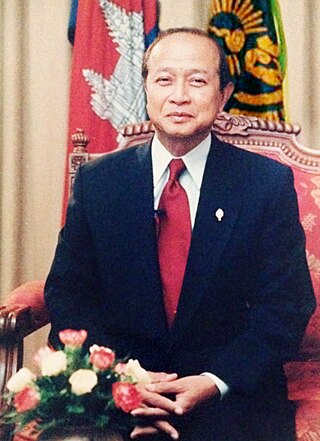
Norodom Ranariddh was a Cambodian politician and law academic. He was the second son of King Norodom Sihanouk of Cambodia and a half-brother of King Norodom Sihamoni. Ranariddh was the president of FUNCINPEC, a Cambodian royalist party. He was also the first Prime Minister of Cambodia following the restoration of the monarchy, serving between 1993 and 1997, and subsequently as the President of the National Assembly between 1998 and 2006.

The National Museum of Cambodia is Cambodia's largest museum of cultural history and is the country's leading historical and archaeological museum. It is located in Chey Chumneas, Phnom Penh.
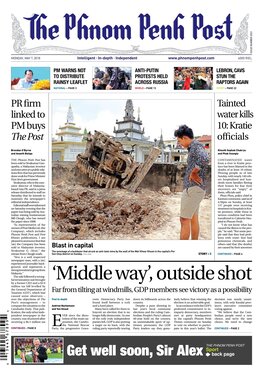
The Phnom Penh Post is a daily English-language newspaper published in Phnom Penh, Cambodia. Founded in 1992 by publisher Michael Hayes and Kathleen O'Keefe, it is Cambodia's oldest English-language newspaper and prior to the transferring of ownership, was considered to be one of Cambodia's newspaper of record. The paper was initially published fortnightly as a full-color tabloid; in 2008 it increased frequency to daily publication and redesigned the format as a Berliner. The Phnom Penh Post is also available in Khmer. It previously published a weekend magazine, 7Days, in its Friday edition. Since July 2014, it has published a weekly edition on Saturdays called Post Weekend, which was folded into the paper as a Friday supplement in 2017 and was discontinued in 2018.
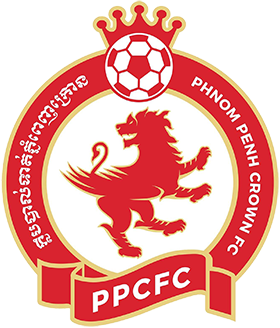
Phnom Penh Crown Football Club, commonly referred to as Crown or PPCFC, is a Cambodian professional football club based in Sangkat Toul Sangke II, Khan Russey Keo, Phnom Penh. The club competes in the Cambodian Premier League, the top flight of Cambodian football.
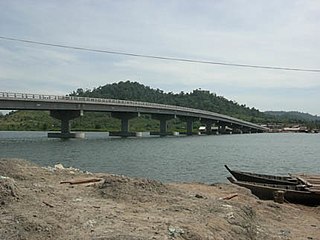
Khemarak Phoumin, also Koh Kong, is the capital and largest city of Koh Kong Province in Cambodia. It is near the mouth of the Kah Bpow river in Smach Mean Chey District on the Gulf of Thailand. The city lies only 10 kilometres (6.2 mi) from the Thai border. It is 138 kilometres (86 mi) by Highway 48 to National Highway 4 at Sre Ambel and a further 133 kilometres (83 mi) to Phnom Penh.
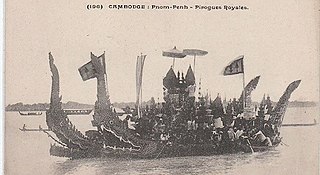
Bon Om Touk, also known as the Cambodian Water Festival, is celebrated in late October or early November, often corresponding with the lunar Mid-Autumn Festival. It marks the end of the monsoon season. The festivities are accompanied by dragon boat races, similar to those seen in the Lao Boun Suang Huea festival.

Vann Molyvann was a Cambodian architect and urban planner. Molyvann is best known as pioneering the style known as New Khmer Architecture, which combined modernism and Khmer tradition, and accounted for the country's unique environment and irrigation needs.

Norodom Boulevard, also called Street 41, is a major boulevard in Cambodia and one of Phnom Penh's oldest arterial roads. It was named after King Norodom. It connects with Monivong Bridge in the south-east of the city at the Bassac River and joins with the north of the city at Wat Phnom.
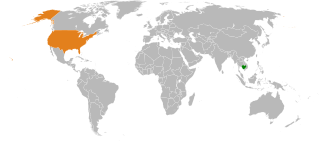
Bilateral relations between the United States and Cambodia, while strained throughout the Cold War, have strengthened considerably in modern times. The U.S. supports efforts in Cambodia to combat terrorism, build democratic institutions, promote human rights, foster economic development, and eliminate corruption.

New Khmer Architecture was an architectural movement in Cambodia during the 1950s and 1960s. The style blended elements of the Modern movement with two distinctly Cambodian traditions: the great Khmer tradition of Angkor and the vernacular architecture tradition of domestic buildings. The term was coined by authors Helen Grant Ross and Darryl Leon Collins.

The Chaktomuk Conference Hall is a theatre located in the city of Phnom Penh, Cambodia. The fan-shaped hall is one of the most iconic works of famous Cambodian architect Vann Molyvann and was since its construction in 1961 one of the "landmarks and infrastructures of the newly independent nation".

Vattanac Capital is a 187.3-metre (615 ft), 39-storey building in Phnom Penh, Cambodia. It is owned by Vattanac Properties Limited, an affiliate of the Vattanac Bank. Construction started in 2009 and the building topped out in May 2012. The majority of the building opened in 2014, while the hotel opened in 2018. The tower is the second skyscraper in Cambodia.

The Fall of Phnom Penh was the capture of Phnom Penh, capital of the Khmer Republic, by the Khmer Rouge on 17 April 1975, effectively ending the Cambodian Civil War. At the beginning of April 1975, Phnom Penh, one of the last remaining strongholds of the Khmer Republic, was surrounded by the Khmer Rouge and totally dependent on aerial resupply through Pochentong Airport.
Vandy Rattana is a photographer and artist, now resident in Taiwan, whose work is concerned with Cambodian society.

Chbar Ampov is a district (khan) in central Phnom Penh, Cambodia.

NagaCorp Ltd. is a Hong Kong-listed hotel, gambling and leisure company. Its Cambodian property, NagaWorld, is the country's largest hotel and gambling resort, and is Phnom Penh's only integrated hotel-casino entertainment complex. NagaCorp holds a 70-year casino licence in Cambodia which runs until 2065, and has a monopoly within a 200-kilometre (120 mi) radius of Phnom Penh until 2045.
Tonlé Bassac is a commune (sangkat) of Chamkar Mon District in Phnom Penh, Cambodia. Lying beside the Bassac River, the area has become a hub of development projects in the last two years, drawing comparisons with Marina Bay, Singapore.
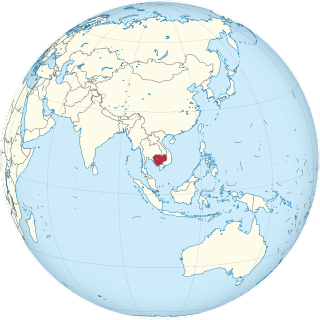
Squatting is common in the country of Cambodia. Following the Khmer Rouge and the Pol Pot regime, the new democratic government introduced land reform. In the capital Phnom Penh, where in 2003 an estimated 25 per cent of the population was squatting, there are informal settlements and occupied buildings.
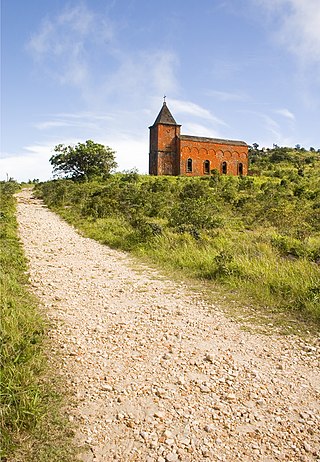
The Church of Mount Bokor also known as the Old Catholic Church of Bokor Mountain is second-oldest standing Roman Catholic church in the Kingdom of Cambodia atop the Bokor Hill Station. Built in the 1920s, it is one of the few churches in Cambodia to have survived the systematic destruction of churches and pagodas under the terror of the Khmer Rouge. Currently in ruins, a restoration project is under development.

















